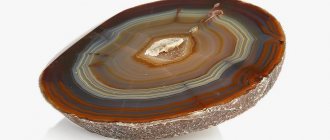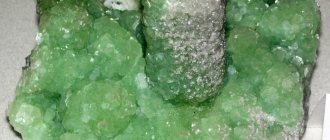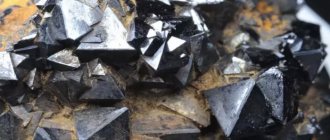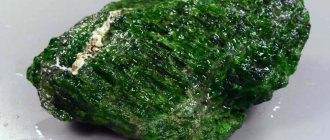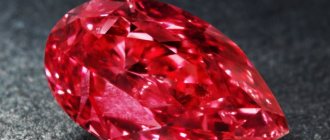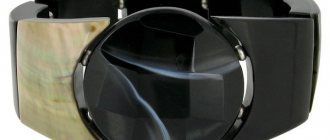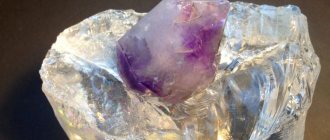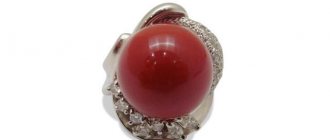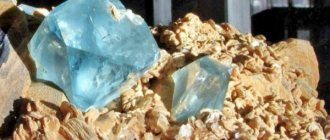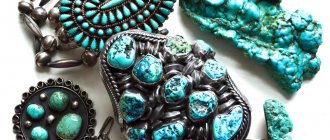Hyacinth is a stone that holds many secrets. There are beautiful legends about its origin. It has a rich red, less often yellow color and crystal transparency.
When processed, the facets of the mineral reflect the rays of the sun, making it look like a diamond. Not only the beauty of the crystal attracts jewelers, magicians and simply connoisseurs of jewelry. The stone has magical properties and can become a valuable amulet.
History and origin
The most famous legend about the origin of the mineral is associated with the Greek king’s son Hyacinth. He, being a very handsome young man, enjoyed the favor of the god of arts Apollo and the god of the southern winds Zephyr. During a discus throwing competition, Zephyr deflected a flying disc with his wind so that Apollo would not win the dispute. The disk hit Hyacinth's head and he died.
Hyacinth
In memory of him, Apollo turned drops of the young man’s blood into luxurious flowers, which, petrified, turned into precious stones. For a long time in Syracuse in July, in honor of Hyacinth, the Hyacinthia festival was celebrated for 3 days.
According to ancient Indian legend, this mineral came to our era from the country of Lemuria, which was located on the site of the Indian Ocean and mystically disappeared. The mineral was called “rahuratka” and was used as a magical amulet with which one could appease the dragon that caused solar eclipses.
The first mentions date back to the 4th century AD. e. Until the 18th century, there was no correct classification of gems, and all stones differed only in color: red ones were considered rubies or garnets, blue ones were sapphires, green ones were emeralds, lilac ones were amethysts, and all orange ones were hyacinths. Only in the middle of the 18th century, the scientist A.G. Werner identified hyacinth as a separate gemstone as a type of zircon.
In ancient Russian books it is mentioned as yacinth or yacinth.
In Rus', jewelry made from hyacinths in gold and silver frames was worn not only by rich people and nobles, but also by ordinary people, using “bechet” beads made from low-quality stones.
The New Testament mentions the hyacinth as number 11 of the 12 stones decorating the base of the wall of Heavenly Jerusalem. The Christian religion dedicated the pink hyacinth to the Apostle Simeon.
Crystal Hyacinth
Hyacinth is a dual mineral; it can activate the best qualities of a person, strengthen friendships, help get out of a state of melancholy and melancholy, or it can provoke aggression and quarrel between people. Since ancient times it was treated with special caution.
Hyacinth in jewelry
When making jewelry, jewelers prefer to set gold-cut gems in the appropriate shades - chocolate, sunny, transparent yellow. Silver cut is more suitable for pinkish and sky-colored hyacinths. But the most luxurious look are bright scarlet stones, which are framed in a high frame made of gold. In this case, a scattering of small diamonds becomes a wonderful addition. Design with transparent zirconium, crystal, opal, amethyst, emerald and other semi-precious and precious stones also looks great.
There is a cutting method called cabochon. This method is used precisely to achieve double refraction of the mineral. Using this method, you can get perfectly smooth and even oval-shaped beads from hyacinth, which will sparkle and playfully shimmer when exposed to sunlight.
Physicochemical characteristics
According to its chemical composition, hyacinth is a type of zircon. It is formed, like all zircons, in the form of crystals.
| Formula | Zr[SiO4] |
| Color | Red-brown, yellow, yellow-red |
| Shine | Strong glass or diamond |
| Transparency | Transparent |
| Hardness | 7—7,5 |
| Cleavage | Imperfect |
| Kink | Conchoidal; very fragile |
| Density | 3.9—4.8 g/cm³ |
Hyacinth mineral is a type of zircon
As already mentioned, hyacinth can be a type of zirconium. Zircon can be a gemstone that has a variety of shades and colors . As a rule, such hyacinth always has an irregular shape . Hyacinth crystals are most often bipyramidal . It is much less common to find a crystal capable of having the form of radiant intergrowths.
Hyacinth, which is a type of zircon, can have several shades:
- Red
- Orange
- Brown
- Red-brown
- Pink
- Yellow
- Golden
Brown hyacinth
Place of extraction
The mineral is formed in different conditions, and its shape depends on the fit of other rocks. In a tight space, crystals stretch out, and where there is free territory, twin crystals or whole druses grow.
The largest crystals can be seen in pegmatite veins. Depending on the deposit, the stones have different colors and sizes.
Deposits in different countries
| Color | A country |
| Transparent, red, orange, pink, yellow | Sri Lanka, Thailand |
| Opaque crystals with clear areas for processing | Canada |
| Red | France |
| Red, mined together with sapphire | Madagascar |
| Brown | Mozambique |
| Red-brown, yellow-brown, deep red, orange | Australia |
| Orange-brown | Brazil |
| Red | Germany |
| Orange-brown | USA |
Deposits in Russia
| Color | Field area |
| Yellow-brown, golden | Transbaikalia |
| Brown, pinkish yellow | Yakutia |
| Transparent | Middle Urals, Kornilov Log mines |
| Yellowish-orange, red-brown, red | Southern Urals, Cherry and Ilmen Mountains |
| Orange-yellow, red-brown | Primorye |
| Yellowish-orange, reddish-brown | Omsk region |
| Honey yellow | Kola Peninsula |
Processed hyacinth
Deposits of this stone are also found in Kyrgyzstan and Ukraine.
Place of Birth
There are quite a lot of gem deposits, but not all of them are rich. The following countries supply the mineral to the world market:
- India;
- USA;
- Thailand;
- Brazil.
On the territory of the Russian Federation, the mineral is found in Yakutia, the Far East, and the Ural Mountains. Several years ago, a large deposit was discovered in Canada. The hyacinth stone is often found together with other jewelry - diamonds, corundums, garnets.
Varieties and colors
The color palette of the stone is quite diverse. He can be:
- brown;
- yellow;
- orange;
- red;
- blood red;
- blue.
The most valuable are red-orange and blue minerals.
In such a science as color science and coloristics, one of the shades of red is called “hyacinth”.
The color of the stone is determined by impurities and additives. If impurities of iron oxides are present, a yellow color is formed, manganese gives all shades of red and pink, iron colors the stone brown, and thanks to chromium, dark blood-red shades appear.
Characteristics of stones by color
- Red hyacinth. Transparent, bright red rich color with deep shine. It is believed that it has a healing effect on the cardiac system. Strengthens marriage for married couples. When heat treated, red hyacinths become transparent, like diamonds. Such samples were called “imperfect diamond” - “Diamant brut”. Fraudsters often took advantage of this, passing off such crystals as diamonds.
Red hyacinth - Blood red hyacinth. It has a thick dark red color, has a lower degree of transparency, and relieves causeless anxiety and fear.
Blood red hyacinth - Yellow hyacinth. The crystal is transparent, light, with a honey tint, has the ability to calm, relieve irritation, immerse you in a contemplative state, can awaken sympathy in other people, and also stimulate the liver.
Yellow hyacinth - Orange hyacinth. Transparent, rich sunny color, gives strength, promotes creativity, gives birth to dreams and hopes for the best.
Orange hyacinths - Blue and cornflower hyacinth are very rare, one in several thousand. However, with the help of firing, the natural brown color changes and becomes blue and blue. The stone helps with diseases of the pancreas.
Blue hyacinth
Some unscrupulous jewelers take advantage of the mineral’s ability to radically change color and pass off ordinary hyacinth as a rare species. Roughly speaking, this is not considered a fake, but the price increases dramatically.
In the past, it was no less valuable than diamonds and emeralds.
Hyacinth gemstone: what it looks like
Not everyone is familiar with a stone like hyacinth. It is not only beautiful, but also shrouded in mystical secrets and magic. Some people create interesting legends about hyacinth, considering hyacinth to be the strongest stone. The word “hyacinth” also belongs to the flower, but the mineral itself is very different from the plant. Especially the color.
Hyacinth is considered a precious stone; its composition is a type of zircon . The color of hyacinth can be light yellow, dark red and even brown. If we compare it with other stones, we can safely say that hyacinth is a “yellow” sapphire or garnet with a brown tint.
It is interesting to know that if hyacinth is subjected to heat treatment for a long time, it completely changes its color and becomes transparent. Transparent hyacinth visually resembles a diamond.
In nature you can also find blue hyacinth , but this is very rare. The found blue pebble will be only one in several hundred “red ones”. Even in ancient times, people learned to burn the mineral so that it would acquire a cornflower blue hue . Modern jewelry companies do the same, trying to replace other precious stones with hyacinth.
When buying jewelry, try to demand a certificate of quality so as not to buy a fake for a lot of money.
Hyacinth is a stone with high hardness (density) . This “allows” you to work with diamond-cut stones. The largest deposits of hyacinth are currently located in Madagascar, Ceylon (Sri Lanka), Thailand and a small deposit in Australia.
Hyacinth stone in nature
Brown hyacinth
Yellow hyacinth stone
Blue hyacinth stone
Medicinal properties of hyacinth
In ancient times, hyacinth was endowed with a large number of medicinal properties.
It was believed that the stone could protect against poisoning and save during epidemics of plague, cholera, protect from evil spirits and terrible dreams. The healing properties were manifested if an amulet was created from the mineral.
Every pharmacy sold a hyacinth mixture prepared from medicinal plants and crushed hyacinth. It was prescribed for almost all diseases.
- Due to the shimmer of shine inside the stone, it was compared to the eyes of a lynx and was considered a stone that helps with blindness and the development of cataracts. With its help, people hoped to restore the same visual acuity as that of the lynx, which perfectly navigates in complete darkness and can, according to hunters, see the tiniest stars in the sky. In ancient recipes from monastic books of the 12th century it is written that “if hyacinth is heated in the sun, then moistened with saliva and applied to the eyes, it will help those whose eyes are darkened, clouded or heavily swollen.”
- Hyacinth was used as a remedy for emotional balance, treating melancholy, melancholy, stress and nervous tension. For patients suffering from hallucinations and mental illness, there was another medieval recipe: “you need to run a hyacinth over warm wheat bread, eat that bread, and the patient will be cured.”
- It was credited with hypnotic properties; it was enough to place it under the pillow or near the bed. He drove away insomnia and nightmares.
- Wounds were healed with the help of hyacinth. Magical treatises describe that hyacinth can stop bleeding if the wound was not caused by a stone or iron.
Amulet with hyacinth
Hyacinth is considered a universal healing stone for the body:
- improves the functioning of the heart and circulatory system;
- treats the liver;
- facilitates digestion;
- helps with skin diseases;
- cleanses the body of toxins;
- normalizes the functioning of the thyroid gland.
Women used hyacinth as a unique means of preserving youth, especially if the hyacinth was inserted into earrings. It helps fight fine wrinkles and dry skin, removes excess water from the body and reduces weight.
In addition, the stone prevents unwanted pregnancy, so those who are expecting a child should not wear it to avoid miscarriage.
Interesting Facts
Curious to know:
- the stone is the only precious grade of zircon;
- in the past, powder made from minerals and plants was sold in European pharmacies - it was believed that it would cure any disease;
- Previously, hyacinth was valued as highly as diamonds and rubies;
- The Hindus believed that the mineral, more than any other rock, was capable of concentrating energy.
Mysterious crystal
The magical properties of hyacinth
Magical properties were attributed to hyacinth primarily due to the double refraction of rays inside the stone. Powerful energy can be useful, or it can cause harm. Moroccan sorcerers still use the stone to make amulets, amulets and as a means of spells.
Red jacinth
It was considered a stone of unhappy love, and unmarried girls are still afraid to wear it as jewelry, so as not to lose their groom or loved one.
It was credited with the ability not to burn in fire and even extinguish the flame, and fabrics acquired fire-resistant properties if hyacinth was wrapped in them.
It was believed that he patronized merchants and travelers, protecting them from troubles along the way, making them prudent and careful. The red crystal attracted money and good luck in business.
The best amulet, which protected even from lightning, was considered to be an uncut hyacinth, which was worn on a simple cord in a small bag around the neck.
Eastern magicians believed that hyacinth promoted the development of mental abilities and intuition and was recommended for philosophers and poets.
For those who are doing well in life, it is better not to wear this stone; it suits people during periods of failure and loss. When the life situation returns to normal, you can take off these jewelry and hide it.
Questions/Answers
Do you know something new about hyacinth? Tell us, we will update the article.
Birthstone - what is it?
It is believed that each gem corresponds to a month of the year and a zodiac sign. This belief was popular 500 years ago. The belief was believed to have originated in the territories of present-day Germany or Poland. Ladies in those days ordered rings from the stone corresponding to their month of birth, and even engraved the sign of the Zodiac on the stone.
But now it has been established that the list of birthstones corresponds to the list from the Apocalypse - the list of twelve stones of the high priest's breastplate.
For those interested, here is the list:
- January. Pomegranate, hyacinth.
- February. Amethyst, hyacinth, pearl.
- March. Jasper, heliotrope.
- April. Sapphire, diamond.
- May. Agate, emerald, chalcedony, carnelian.
- June. Emerald, agate, chalcedony, turquoise, pearls, cat's eye.
- July. Onyx, sardonyx, carnelian, ruby, turquoise.
- August. Carnelian, sardonyx, heliotrope, topaz, alexandrite.
- September. Chrysolite, sardonyx.
- October. Beryl, aquamarine, opal.
- November. Topaz, pearls.
- December. Ruby, turquoise, chrysoprase, heliotrope.
Expert opinion
Semenishcheva Polina
Specialist in mineralogy. Graduated from St. Petersburg Mining University.
For your information: the list (with some adjustments) was approved by the National American Jewelers Association back in 1912.
How to distinguish a fake?
You won't be able to spot a fake on your own. You will have to contact specialists, or trust the certificate (if there is one).
Fraudsters sell cubic zirconia as hyacinth. Fortunately, they are cheap, and their colors are amazing in variety.
Hyacinth can be obtained artificially. But a specialist can easily distinguish imitation from natural stone.
How to care?
The gem has no special whims.
- He doesn't like high humidity. But you can wipe the contaminated stone with a damp cloth.
- He doesn't like heat. Therefore, tropical countries, baths and saunas are contraindicated for stone.
- Be sure to store your jewelry in a thick fabric bag or case with soft inner walls.
Who should wear it?
Traders, small and large.
For those who study. Not just for children.
Note : Happy brides, do not wear this beauty stone. He will destroy love, and it is unknown when the next groom will be found...
How to wear?
- As an amulet, the best option is a simple pendant, preferably on a leather cord.
- As a decoration, the gem will manifest its magical properties when set in gray metals.
- Some esotericists advise wearing a gem in a ring.
- Don't like jewelry? Place a crystal in your pocket. Even untreated will do.
Important : it is better not to wear the gem constantly.
Otherwise, the capricious magic of the stone will turn against the owner. What is the price?
You can only buy a fake cheaply. Natural hyacinths, especially blue and orange hyacinths, are highly prized.
Prepare your money, first look in online stores, then take a tour of jewelry stores. Be explorers and seekers.
It will be a little adventure from which you will return with a new decoration.
What colors are there?
All shades of autumn:
- red;
- orange;
- red-brown;
- amber;
- yellow-red;
- honey;
- pink;
- burgundy
Natural blue crystals occur, but are extremely rare.
Where can I buy?
Jewelers today love to combine several gems in jewelry. Sometimes interesting things come out. You can buy these in online stores and in large jewelry stores.
Blue hyacinth cannot be found in ordinary jewelry stores. It can be purchased at auctions.
When is the best time to buy?
On the sixth lunar day. But this is the case if you plan not only to “ see it for yourself and show it to people ,” but to use the magical properties of the gem.
What stones does it go with?
Hyacinth will live peacefully with:
- pearls;
- amethyst;
- beryls;
- emerald.
The energy of hyacinth conflicts with the energy of:
- ruby;
- disgrace;
- moonstone (adularia);
- malachite
There are gems to whose presence our handsome man is indifferent. This:
- chrysolite;
- topaz;
- diamond.
Are there blue hyacinths?
Eat. But they are extremely rare, and their price is orders of magnitude higher than ordinary hyacinths. But this applies to natural blue hyacinths.
There are also fakes. This is not to say that these are not hyacinths. They are, they just got an unattractive, dirty brown color from birth. But if this “ugly duckling” is annealed, it becomes colorless or pale blue. Such a handsome man can be passed off as a blue hyacinth or a fancy diamond.
Interesting : this method has been known to jewelry scammers for a very long time.
Hyacinth and zodiac signs
The stone has a dual reputation, and for some zodiac signs it will be an assistant and support, while for others it is strictly contraindicated. The stone should not be worn constantly; it quickly becomes saturated with the energy of the owner. Therefore, it must be immersed in a crystal glass with clean water for several days to purify it; the water must be poured out.
| Zodiac sign | Compatibility |
| Aries | + |
| Taurus | + |
| Twins | + |
| Cancer | + |
| a lion | + |
| Virgo | + |
| Scales | + |
| Scorpion | + |
| Sagittarius | + |
| Capricorn | +++ |
| Aquarius | + |
| Fish | + |
(“+++” – fits perfectly, “+” – can be worn, “-” – is strictly contraindicated)
Fashion for hyacinth
For quite a long time, ligurium and hyacinth were considered related stones, although this is absolutely not the case. This happened due to the fact that Epiphanius, an elder who lived in the fourth century AD, while compiling a complete list of stones, saw that hyacinth was not included in it. Realizing that the stone deserved to be included in the inventory, the sage added hyacinth to the list instead of ligurium.
The unusual hyacinth was extremely popular. The bright stones, sparkling in the sun, were endowed with special love. The ancient Greeks, who idolized the stone most of all, endowed it with magical powers and believed that it was capable of giving selfless love and preserving the masculine principle. Every self-respecting person was simply obliged to have such a stone. There was an opinion that the extent to which a stone maintains reflective properties, the reputation of its owner is so impeccable, so honest is he with others.
Among the fair half of humanity, hyacinth also enjoyed considerable popularity. Women from high society always had bright hyacinths; they looked especially good on those who had porcelain-colored skin and light hair color. The ladies were sure, and this was not disputed by anyone, that the stone ideally complemented their beauty, emphasized individuality and femininity. Girls from poor classes also kept up with fashion; commoners believed that an unusual stone would help them meet their betrothed and get married quickly and successfully.
Compatibility with other stones
| Compatibility with other stones | Stones |
| Goes well | White pearl, beryl, agate, turquoise, emerald, sapphire, coral, carnelian, amethyst |
| Neutral combination | Carnelian, golden topaz |
| Questionable combination | Rock crystal, jasper, moonstone, garnet, opal, aquamarine |
| Prohibited combination | Onyx, obsidian, malachite, sardonyx, marcasite |
Hyacinth does not accept combination with any of the alexandrite stones. It is advisable that the decoration have an odd number of stones, this attracts happiness and good luck.
Jewelers select gems for jewelry and according to the rules of stone color combinations.
- stones are combined only with transparent stones, for example, diamonds;
- yellow stones do not combine with blue and purple ones;
- Blue gems cannot be combined with orange and yellow ones.
It is better to frame this mineral in gold or silver.
Copper and its alloys neutralize the protective and healing properties of hyacinth. Yellow and brown stones look better in gold, while red and blue stones look better in silver.
Magical and healing features
Hyacinth stone has magical properties. The use of the mineral helps achieve the following effects:
- Become more confident and positive. Under the influence of the mineral, a person becomes more alert and saturated with vital energy.
- Get rid of melancholy and sorrow.
- Heal from worries about unhappy love. Hyacinth helps people with a broken heart find peace and gives them hope.
- Cope with anxiety and fears.
- Concentrate on important matters. The stone sharpens attention.
In moments of happiness, it is better not to wear the mineral. It can bring trouble and even destroy great love.
Jewelry with crystals helps to recharge yourself with positivity.
In addition to magical properties, hyacinth is endowed with pronounced healing characteristics. They appear as follows:
- normalization of the digestive organs;
- improved appetite;
- cleansing the body of toxic substances;
- improvement of visual functions;
- eliminating the effects of stress and depression;
- restoration of a person’s physical and emotional strength;
- relief of inflammation.
The mineral is considered a real assistant for representatives of creative professions. It should also be worn by people who, due to the nature of their work, spend a lot of emotions.
The properties of hyacinth allow it to be used for medicinal purposes.
Application area
Hyacinth is used to make a variety of jewelry. The stone is quite durable and not sensitive to heat, so there are no particular difficulties in processing it.
Jewelry with hyacinth
It is processed with a diamond cut, but most often it is cut in the form of a cabochon or beads that have no edges.
This makes it possible to effectively show the double refraction of rays in a gem.
The surface of the stone can be damaged from daily wear, so it is set in a blind frame. To protect against damage, it is better to use hyacinth in earrings and pendants. In pendants it can be framed or used as an independent decoration.
Quite common decorations with hyacinth are rings and rings. Depending on the color of the stone and its size, you can choose an interesting option for both men and women.
Particularly interesting are the options in the form of a necklace or bracelet. As a rule, these are original works.
All products with hyacinths look very impressive and expensive.
Properties and uses of the mineral
The properties of hyacinth are described even in ancient books. The stone has high physical and chemical qualities. It is slightly inferior in hardness to a diamond, but this indicator is also high.
Hyacinth is used not only in the jewelry industry. The mineral has always been credited with magical and healing effects.
Physical and chemical properties
The mineral formula is Zr(SiO4). Depending on the color, its structure contains impurities of other substances. Hyacinth is a silicate. Accordingly, the color of his trait is white.
The crystals have a pyramidal or prismatic shape. They are distinguished by imperfect cleavage and conchoidal brittle fracture. At the same time, the hardness of the stone is high (7–8 on the mineralogical scale).
With prolonged exposure to sunlight, the stone loses its shine and becomes dull. The same thing happens if you place hyacinth in warm water for a long time. To restore color and shine to the crystal, it is placed in an acidic environment and kept there at high temperatures.
Medicinal properties
In ancient times, hyacinth was credited with medicinal properties. It was even ground into powder and used as a medicine for oral administration.
Healing properties of the gem:
- stabilizes the psycho-emotional state;
- prolongs youth;
- improves the condition of the cardiovascular system;
- reduces pain syndrome of inflammatory etiology;
- normalizes appetite;
- helps cope with diseases of the liver and gastrointestinal tract;
- accelerates the regeneration of wounds that were not caused by metal.
In ancient times, hyacinth was used to treat the effects of lightning strikes. A mixture of herbs with mineral powder was prescribed as an immunostimulating and general tonic.
Magic properties
Since ancient times, magical properties have been attributed to hyacinth:
- It was believed that it was able to protect its owner from deadly infectious diseases, curses and other misfortunes.
- Sailors and merchants always took hyacinth products with them on their travels. They protected them from harm and helped them return home.
- Hyacinth is a symbol of wisdom. It helps you make the right decisions. It is recommended to be worn by scientists, businessmen for important negotiations and students for exams.
The magical properties of the crystal are contradictory. It helps those who are suffering, but can harm happy people.
When a person experiences mental anguish, suffers from loneliness or unrequited love, the stone attracts good luck and a soul mate to its owner. It helps to cope with worries, find happiness and peace.
If everything is good in life, jewelry with hyacinth should be put aside. In this case, the crystal will attract bad luck, quarrels in the family, and may even cause lovers to separate.
The best amulet is considered to be hyacinth beads strung on a simple thread. Silver exhibits the magical properties of the mineral well.
Hyacinth framed with copper cannot be used as an amulet. Such metal muffles all the mystical properties of the amulet.
In addition to the topic about the meaning of the stone, watch the video:
Suitable by zodiac sign and name
The stone is suitable for people prone to frequent experiences. It is best worn by the following zodiac signs:
- Sagittarius;
- Aquarius;
- Capricorns.
There are no signs prohibiting the use of jewelry with this mineral. But it is important to remember that the stone can attract bad luck to the owner, which he will not like.
The name has an impact on personality. There are names for whose owners hyacinth is most suitable:
| Women's | Men's |
| Yaroslav | Yaroslav |
| Victoria | Alexander |
| Amina | Egor |
| Galina | Basil |
| Margarita | Paul |
| Renata | Oleg |
| Yana | a lion |
| Sofia | Victor |
| Vasilisa | Kirill |
How to spot a fake
When purchasing a product with hyacinth, you need to know some subtleties that will help you not buy a fake. Bring a 10x magnification magnifying glass with you to the store.
- A real stone has impeccable transparency and diamond shine. Inclusions, veins, cracks and other defects are not allowed.
- The cut should be smooth without any roughness, scratches or chips.
- The color of the stone is even and rich, the crystal is evenly colored, it is completely impossible to imitate the color of natural stone.
- Natural stone is always cold to the touch, unlike glass, which reaches room temperature.
Ring with hyacinth
An artificial synthetic crystal cubic zirconia, despite its external similarity, has nothing to do with hyacinth and is not a precious stone. Confusion arises when the English name for cubic zirconia is used - “zirconium cube”.
You should buy such expensive jewelry only in specialized stores, where they can present a certificate for the product.
Price
The cost of hyacinth jewelry depends on the size of the stone and what metal the frame is made of.
The price range is wide:
- regular quality hyacinth - $10–20 per carat .
- rare high quality stones - $300–500 per carat .
It is better to buy expensive jewelry from trusted sellers who provide certificates for the products.
Examples of prices in Russian online stores:
- ring (925 sterling silver, 750 gold) — RUB 22,000. ;
- hyacinth, 7 carats (11.6 x 10.0 x 6.7 mm) - RUB 30,000.
How to wear and care
All gemstones need proper care and storage. This is especially important for hyacinth.
- It should not be exposed to the sun for a long time, it should not be brought close to the fire, otherwise it will lose its transparency and shine and become dull. You can restore shine by strongly heating the stone in an acidic environment, although jewelers claim that it is impossible to restore the original color.
- Contact with water and damp environments is undesirable.
- The stone is cleaned with a soft cloth made from natural materials; the use of cleaning agents is not allowed.
- It is necessary to carefully care for the frame in accordance with the recommendations for this metal (care for gold and silver is different).
- It is better to store these jewelry in a separate box.
Caring for products with hyacinth
Protect the gem from shocks, falls, friction, and high temperatures.
Hyacinth is hard, but also fragile. The gem is not too picky, but it is better not to abuse its unpretentiousness. There are a few simple rules that will help keep it safe and sound.
Many gemstones, including hyacinth, do not like direct sunlight. Therefore, wear your gem only under clothes. Under the influence of rays, the mineral becomes cloudy, loses its richness of colors and play of light.
It is better to remove jewelry with hyacinth if you go to the pool or start cleaning: the stone does not like chemicals. To clean, rinse with water and dry with a cotton towel.
